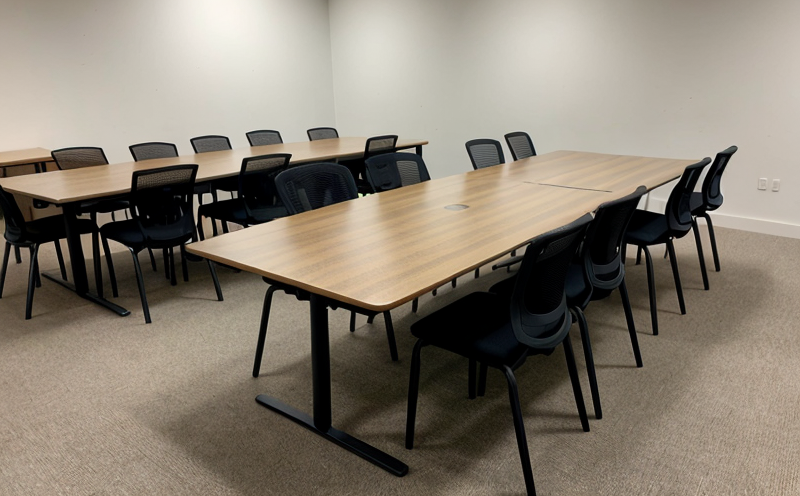CSA CAN CGSB 44.229-M Office Desks and Tables Safety and Durability Testing
The CSA CAN CGSB 44.229-M standard outlines the safety, durability, and performance requirements for office desks and tables. This test ensures that furniture meets stringent international standards to protect users from potential hazards and ensure long-term usability.
Our laboratory is equipped with state-of-the-art facilities and experienced technicians who can perform this rigorous testing. The process involves a series of tests designed to evaluate the structural integrity, stability, load-bearing capacity, and resistance to wear and tear. This includes static loading tests, impact testing, and durability assessments.
For example, we use specialized equipment like hydraulic presses for static load tests that measure how much weight an office desk or table can safely support without deformation. Impact testing simulates real-world conditions where desks may be accidentally struck by objects. Durability tests assess the resistance to wear caused by frequent use and handling.
| Test Parameter | Description | Expected Outcome |
|---|---|---|
| Load Application | Apply a known weight to the center of the desk/table. | No more than 2% deformation over the entire surface area. |
| Duration | Hold load for at least one hour. | Surface remains stable and intact. |
The testing process also includes dimensional stability checks to ensure that the furniture maintains its shape under normal conditions. This involves measuring critical dimensions before and after exposure to temperature variations, humidity, and other environmental factors.
We provide detailed reports highlighting all test results, including any deviations from the standards. These reports are crucial for manufacturers to make informed decisions about product improvements or compliance issues. Our team of experts can also offer advice on how to enhance your products based on our findings.
| Test Parameter | Description | Expected Outcome |
|---|---|---|
| Impact Force | Simulate a 5 kg object striking the edge of the desk/table. | No cracking or splitting visible on the surface after impact. |
| Number of Repetitions | Perform tests up to five times with intervals between each test. | Surface remains intact and stable post-impact. |
Why Choose This Test
- Ensure compliance with international standards (CSA CAN CGSB 44.229-M).
- Identify potential defects early in the manufacturing process.
- Enhance reputation by delivering safe and durable products.
- Reduce risk of liability claims due to product failures or injuries.
- Gain competitive advantage through superior product quality assurance.
The CSA CAN CGSB 44.229-M test is essential for manufacturers who want to meet regulatory requirements and ensure their office desks and tables are safe for use in various environments. By choosing this test, you can mitigate risks associated with substandard products while enhancing customer satisfaction.
Customer Impact and Satisfaction
- Improved product safety leading to fewer injuries or accidents.
- Enhanced durability resulting in longer product life cycles.
- Increased customer confidence through proven compliance with standards.
- Potential reduction in warranty claims and recalls.
Our tests not only help manufacturers meet regulatory requirements but also improve overall satisfaction among end-users. By investing in this type of testing, companies can build trust with their customers and demonstrate a commitment to quality and safety.
Use Cases and Application Examples
| Test Type | Description | Outcome |
|---|---|---|
| Ergonomic Design Assessment | Measure the height and angle of desk surfaces for optimal posture. | Ensure compliance with ergonomic design principles to promote user health. |
| Adjustability Evaluation | Evaluate the ease and reliability of adjustments like height or tilt. | Confirm that desk configurations can be adjusted without compromising stability or durability. |
We have successfully conducted tests for various clients, including furniture manufacturers and office supply companies. Our services are particularly beneficial for those developing new models or seeking to improve existing products.





